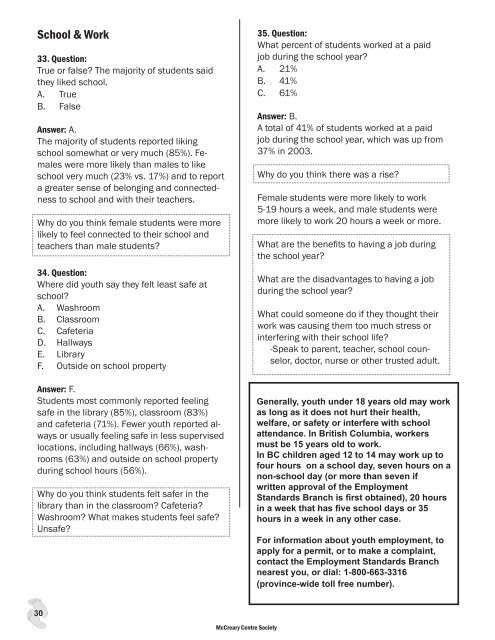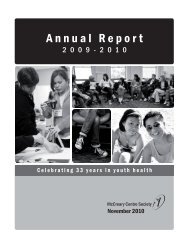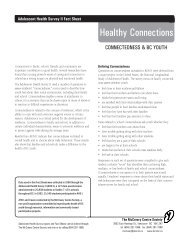Talking About Youth Health in BC
Next Steps G7-12 Cover.psd - McCreary Centre Society
Next Steps G7-12 Cover.psd - McCreary Centre Society
You also want an ePaper? Increase the reach of your titles
YUMPU automatically turns print PDFs into web optimized ePapers that Google loves.
School & Work33. Question:True or false? The majority of students saidthey liked school.A. TrueB. FalseAnswer: A.The majority of students reported lik<strong>in</strong>gschool somewhat or very much (85%). Femaleswere more likely than males to likeschool very much (23% vs. 17%) and to reporta greater sense of belong<strong>in</strong>g and connectednessto school and with their teachers.Why do you th<strong>in</strong>k female students were morelikely to feel connected to their school andteachers than male students?34. Question:Where did youth say they felt least safe atschool?A. WashroomB. ClassroomC. CafeteriaD. HallwaysE. LibraryF. Outside on school propertyAnswer: F.Students most commonly reported feel<strong>in</strong>gsafe <strong>in</strong> the library (85%), classroom (83%)and cafeteria (71%). Fewer youth reported alwaysor usually feel<strong>in</strong>g safe <strong>in</strong> less supervisedlocations, <strong>in</strong>clud<strong>in</strong>g hallways (66%), washrooms(63%) and outside on school propertydur<strong>in</strong>g school hours (56%).Why do you th<strong>in</strong>k students felt safer <strong>in</strong> thelibrary than <strong>in</strong> the classroom? Cafeteria?Washroom? What makes students feel safe?Unsafe?35. Question:What percent of students worked at a paidjob dur<strong>in</strong>g the school year?A. 21%B. 41%C. 61%Answer: B.A total of 41% of students worked at a paidjob dur<strong>in</strong>g the school year, which was up from37% <strong>in</strong> 2003.Why do you th<strong>in</strong>k there was a rise?Female students were more likely to work5-19 hours a week, and male students weremore likely to work 20 hours a week or more.What are the benefits to hav<strong>in</strong>g a job dur<strong>in</strong>gthe school year?What are the disadvantages to hav<strong>in</strong>g a jobdur<strong>in</strong>g the school year?What could someone do if they thought theirwork was caus<strong>in</strong>g them too much stress or<strong>in</strong>terfer<strong>in</strong>g with their school life?-Speak to parent, teacher, school counselor,doctor, nurse or other trusted adult.Generally, youth under 18 years old may workas long as it does not hurt their health,welfare, or safety or <strong>in</strong>terfere with schoolattendance. In British Columbia, workersmust be 15 years old to work.In <strong>BC</strong> children aged 12 to 14 may work up tofour hours on a school day, seven hours on anon-school day (or more than seven ifwritten approval of the EmploymentStandards Branch is first obta<strong>in</strong>ed), 20 hours<strong>in</strong> a week that has five school days or 35hours <strong>in</strong> a week <strong>in</strong> any other case.For <strong>in</strong>formation about youth employment, toapply for a permit, or to make a compla<strong>in</strong>t,contact the Employment Standards Branchnearest you, or dial: 1-800-663-3316(prov<strong>in</strong>ce-wide toll free number).30McCreary Centre Society






